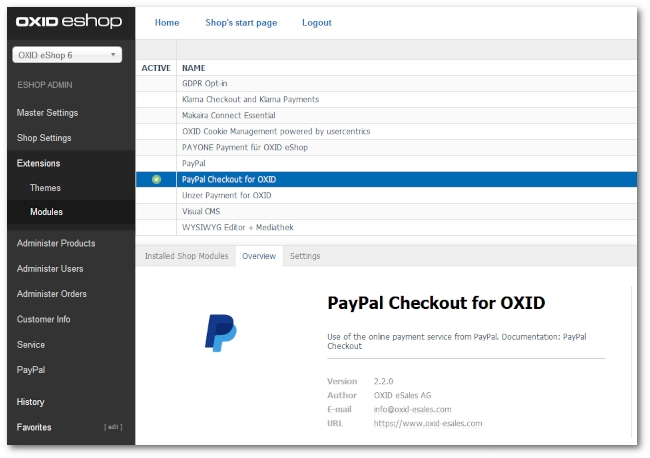Installation
To install the PayPal Checkout payment module, install different versions depending on your OXID eShop version:
If you have OXID eShop version 7.x, install PayPal Checkout 3.x (see Installing PayPal Checkout).
If you have OXID eShop version 6.3.x to 6.5.x, install PayPal Checkout 2.x.x.
For more information, see the corresponding module documentation under Installing PayPal Checkout 2.5.x.If you have OXID eShop version 6.1.x or 6.2.x, install PayPal Checkout 1.x.x.
For more information, see the corresponding module documentation under Installing PayPal Checkout 1.3.x.
Earlier versions of OXID eShop are not supported.
Installing PayPal Checkout
For OXID eShop version 7.x, install the payment module PayPal Checkout version 3.5.x.
Prerequisites
You have installed OXID eShop version 7.x.
You have configured https.
In the
<root directory of the eShop>/sourcedirectory, open theconfig.inc.phpfile.Make sure that https is set for the base URL (shopURL parameter).
Example:$this->sShopURL = 'https://www.example.org';
Procedure
Open a shell and change to the root directory of the eShop (where the file
composer.jsonis located).
Example:cd /var/www/oxideshop
Execute the following command:
composer require oxid-solution-catalysts/paypal-module ^3.5.0
Optional: To activate the module, run the following command.
Alternatively: Activate the module manually during configuration (see Activating PayPal Checkout manually)../vendor/bin/oe-console oe:module:activate osc_paypal
Result
When the installation process is finished, the module PayPal Checkout for OXID appears in the administration area under (Figure: PayPal Checkout for OXID installed and activated).

Figure: PayPal Checkout for OXID installed and activated
Installing a minor update
If you use a deprecated version, perform a minor update, for example from PayPal Checkout version 3.4.0 to version 3.5.0.
Procedure
Execute the following console commands:
composer require --update-with-all-dependencies oxid-solution-catalysts/paypal-module ^3.5.0
To be able to use new payment methods or functions, go through the registration process (onboarding) again.
For more information, see API Credentials: Onboarding.